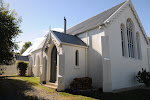
And so, just before the roof was sealed up for the flue and chimney, I took this photograph of the hole revealing the double roof layer. Not a bad thing to have two layers, but how the church now functions with a good stove will determine what other kind of insulation we need in the roof and on the windows.
After the first day of the wood heaters operation it was fantistic to feel the heat rising up into the mezzanine level. This means that the church has the potential to be used all the year instead just the warmer months. Heating is the issue here, in Queensland it was cooling, and we are now entering into our first Tasmanian winter-not as bitter as in the UK, but cold nonetheless.




